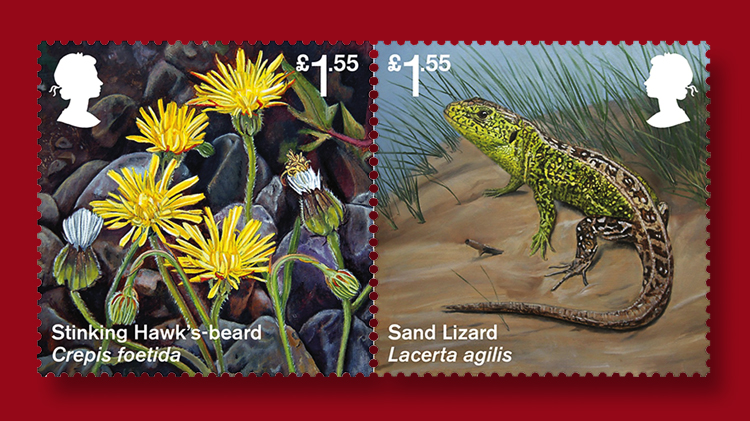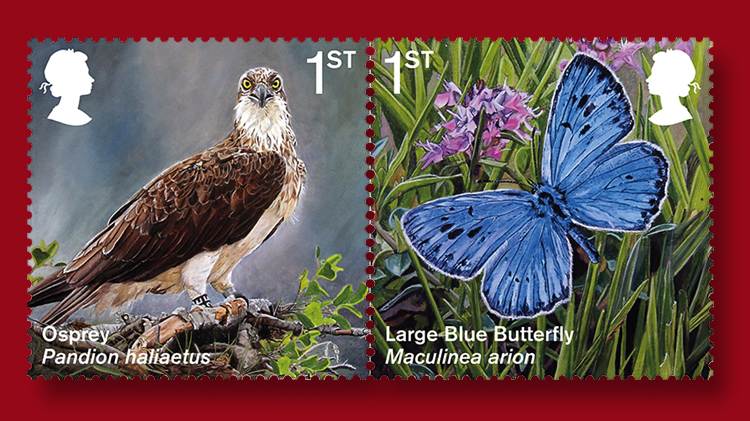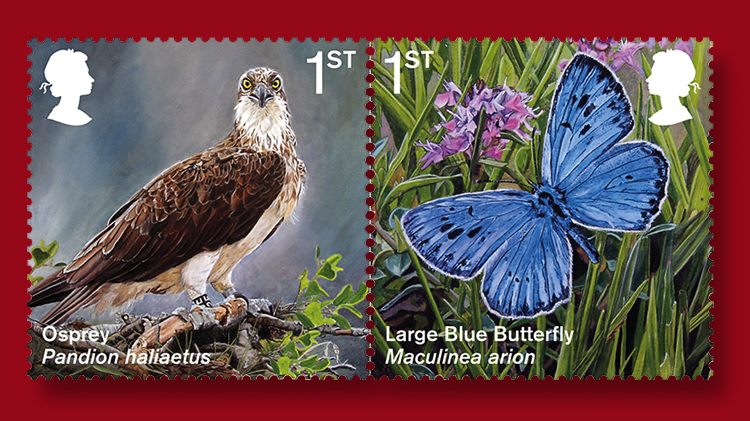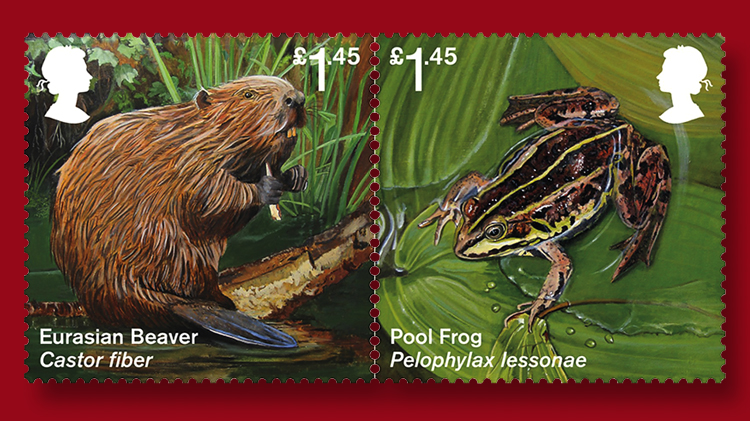World Stamps
New Royal Mail stamps dedicated to the reintroduction of six species
By Denise McCarty
Six new stamps from Great Britain picture species that were once extinct in the United Kingdom but have been successfully reintroduced.
Royal Mail is issuing the six Reintroduced Species stamps April 17 in three se-tenant pairs, each with two side-by-side designs.
The first pair features the osprey (Pandion haliaetus) and the large blue butterfly (Maculinea arion) on nondenominated first-class stamps. The first-class domestic rate is currently 67 pence.
A fish-eating hawk, the osprey became extinct as a breeding bird in England in 1840 and in Scotland in 1916.
The slow process of recolonization in Scotland started naturally in 1954. In 1996, 64 ospreys from the Scottish Highlands were relocated to England, and, by 2001, they were rearing their own young there.
The large blue butterfly was shown on a previous British stamp in 1981 (Scott 942), two years after it had been declared extinct in the United Kingdom.
Now the United Kingdom is believed to have the largest concentration of large blue butterflies in the world, with more than 10,000 on reserves in Gloucestershire and Somerset, according to an August 2016 report on the BBC website.
The species reintroduction began in 1984, and the BBC report said that the “key to the success of the programme was an understanding of the butterfly’s bizarre life-cycle which is similar to that of the cuckoo.”
Like cuckoos, which often lay their eggs in the nests of other birds, large blue butterfly caterpillars use red ants to raise their offspring.
Pictured on the pair of £1.45 stamps are the Eurasian beaver (Caster fiber) and pool frog (Pelophylax lessonae). These stamps pay the rate for international letters up to 20 grams and international economy letters up to 100 grams.
The Woodland Trust, told the story of the reintroduction of Europe’s largest rodent, the Eurasian beaver: “Hunted to extinction around five hundred years ago, beavers were officially reintroduced to the UK in 2009 at Knapdale, Argyll as part of a Scottish government trial. However, these were not the first to return. A few years earlier, beavers were discovered on the River Tay, having either escaped from captivity or been illegally released. In 2010, a similar situation occurred on the River Otter, Devon, with a population of unknown origin becoming established. Several other beavers have since been released on the river as part of a government-sanctioned trial. Another reintroduction trial is set to take place in the Forest of Dean.”
The pool frog, also known as the northern pool frog, occurred naturally in East Anglia until 1995. From 2005 to 2008, pool frogs and tadpoles from Sweden were transferred to one site in the area, and a second site was added in 2015.
The pool frog is still endangered and it is illegal to “kill, injure, capture or disturb them, and to damage or destroy pool frog breeding or resting habitat,” according to Amphibian and Reptile Conservation.
The only plant in the set, the stinking hawk’s-beard (Crepis foetida), is pictured on one of the two £1.55 stamps. The other depicts the sand lizard (Lacerta agilis). These stamps pay the rate for letters to Europe up to 100 grams.
A member of the Asteraceae, family, the stinking hawk’s-beard resembles the dandelion and, when touched, it omits a smell that has been compared to bitter almonds.
Royal Mail reports that this plant never had a common presence in the United Kingdom “being limited to the coastal shingle of Kent and Essex, and scattered inland sites mainly in south-east England, on chalk and sandy soils.”
In a July 2009 article for Scientific American, John Platt wrote about the reintroduction efforts: “… the organizations Natural England, the Royal Society for the Protection of Birds (RSPB), and Royal Holloway College have initiated several projects to try to reintroduce the plant, using seeds collected before it died off. Those first reintroduction projects failed or had limited success, but they offered enough information to help with the latest, successful, effort. Now at least 1,000 plants are thriving at the Rye Harbour Nature Reserve, where just 10 plants existed four years ago.”
As its name suggests, the sand lizard’s natural habitat is in sand, including dunes and sandy lowland heaths of the United Kingdom. Due to the loss of this habitat, the lizard had become extinct in different locations.
Royal Mail said, “But with more than 70 reintroductions of over 9,000 lizards, captive breeding has helped end their decline.”
Like the pond frog, the sand lizard is strictly protected in the United Kingdom. This egg-laying lizard can live up to 20 years, according to the Wildlife Trusts.
Godfrey Design in London designed the stamps, using illustrations by wildlife artist Tanya Lock.
The stamps are square, measuring 35 millimeters by 35mm each, and are perforated gauge 14.5. International Security Printers printed them by offset in sheets of 60, sold in panes of 30 at most postal outlets.
Royal Mail’s other products for the Reintroduced Species set include first-day covers, six postcards reproducing the designs of the stamps, and a presentation pack with mint examples of the stamps and text by television presenter and naturalist Chris Packham.
Connect with Linn’s Stamp News:
Sign up for our newsletter
Like us on Facebook
Follow us on Twitter
Ordering information is available from Royal Mail, Tallents House, 21 S. Gyle Crescent, Edinburgh, EH12 9PB, Scotland.
Royal Mail’s agency in the United States is Interpost, Box 420, Hewlett, NY 11557.
MORE RELATED ARTICLES
Headlines
-
US Stamps
Oct 7, 2024, 3 PMMcMurtrie dismissed as APS education director following Sept. 21 arrest
-
US Stamps
Oct 7, 2024, 12 PMVasiliauskas named president of Mystic Stamp Co.
-
US Stamps
Oct 6, 2024, 5 PMApgar souvenir card available
-
US Stamps
Oct 6, 2024, 4 PMFirst Continental Congress and U.N. stamps receive Scott catalog numbers












